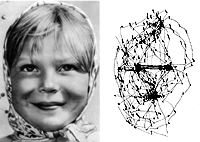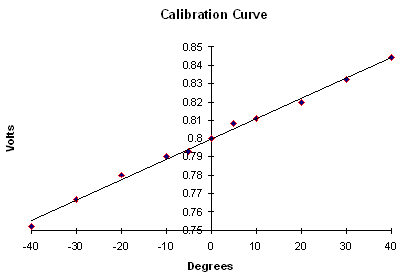|
Biological Signals Acquisition |
EOG tests > saccades |
| |
Saccadic eye movements
(saccades) are generated to move the eye rapidly to a specific target of
interest in visual space. |
|
The word saccade originated from the French term for "jerk", named so to
reflect the great speed at which these eye movements occur. Eye
movements are generally described in terms of the angle (in degrees)
that the eye has rotated. Saccades last for only a fraction of a second
and can reach speeds up to 900 deg/s. |
| Saccades are under
voluntary
control and can be made in the dark, or
with the eye closed. During our daily
activities, we constantly generate
saccadic eye movements to scan our visual
surroundings. When viewing an object of
interest, we make saccadic eye movements
to specific features of the image in
order to analyze it; in the case of the
human face, saccades are made primarily
to areas containing the eyes (see figure
to the right). |
 |
|
(from Yarbus,
"Eye Movements and Vision",
Plenum Press, NY, 1967) |
|
Likewise while
reading we generate small saccadic eye
movements to move from word to word,
phrase to phrase and line to line. |
|
Saccades/Calibration
Curve: Procedure |
| Eye movements are measured
in degrees. However the signal that you
will record from the EOG electrodes will
be in volts. In order to determine the
relationship between the amplitude of the
measured voltage and the actual eye
movement generated by the subject, it is
necessary to construct a calibration
curve. |
-
The
subject sits 7 inches from the
monitor and the
"target" option is
chosen
-
First
the leftward targets: The subject
fixates on the center ball
(blue), and then focuses on the
red balls as they appear at -5,
-10, -20, -30 and -40 degrees.
After this trial is completed,
the data is saved.
-
Then
the rightward targets: The
subject focuses on the central
blue ball, and then the red balls
as they appear at 5, 10, 20, 30
and 40 degrees . After this trial
is completed, the data is saved.
|
|

|
Sample
Targets |
| |
| |
|
Saccades/Calibration
Curve: Results |
|
Saved Data for
Leftward Moving Targets
 |
|
Saved Data for
Rightward Moving Targets
 |
| We now
have a set of data that relates voltage
to the actual eye position. From this
data we will construct a calibration
curve to obtain the calibration factor or
coefficient, which we can use to convert
voltages obtained during various eye
tests to the actual displacement in
degrees the eye made. |
| Degrees |
-40 |
-30 |
-20 |
-10 |
-5 |
0 |
+5 |
+10 |
+20 |
+30 |
+40 |
| Voltage |
0.752 |
0.767 |
0.78 |
0.79 |
0.793 |
0.8 |
0.808 |
0.811 |
0.82 |
0.832 |
0.844 |
|
 |
| The graph
should be linear over most of the range
-40 to +40 degrees. After fitting the
best fit line, the slope is determined.
For this example, |
|
the slope or
calibration factor = 0.0011
volts/degree. |
|
To continue with the next
topic, Smooth pursuit, click here |